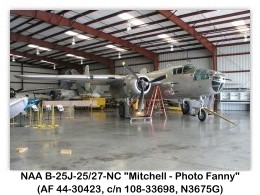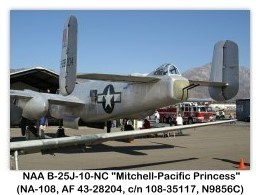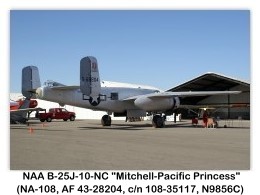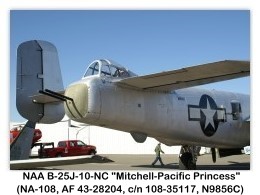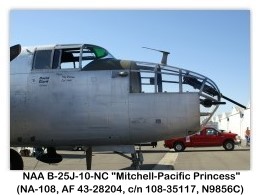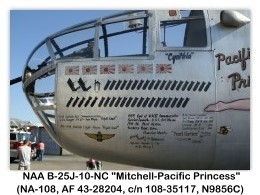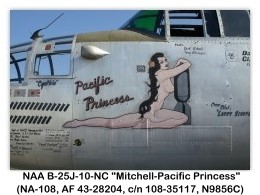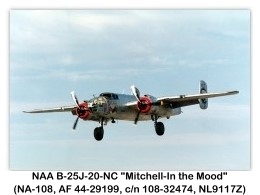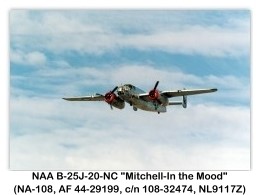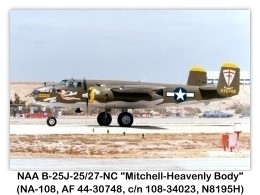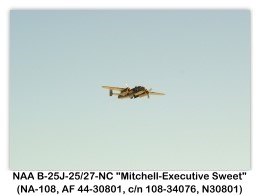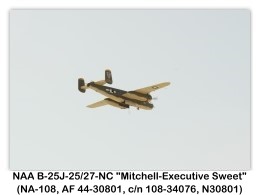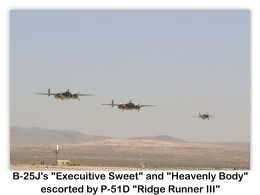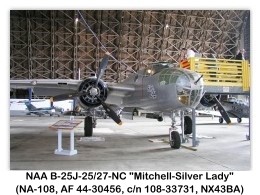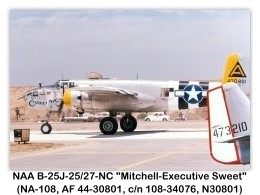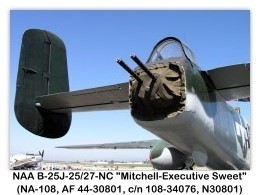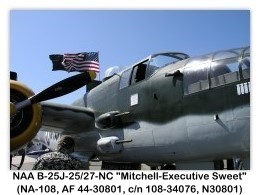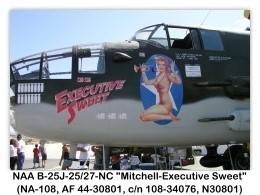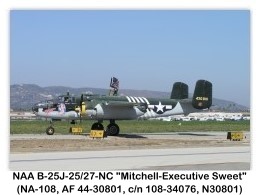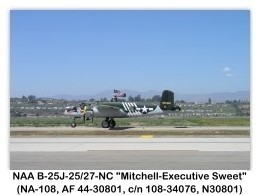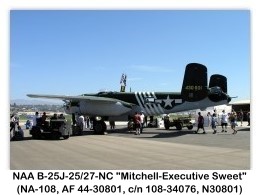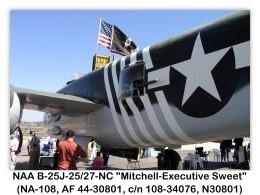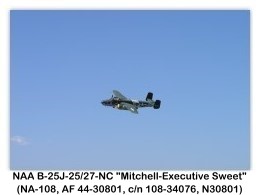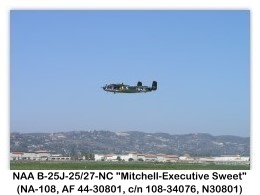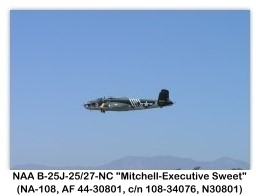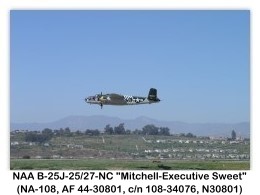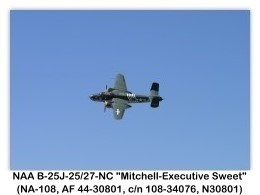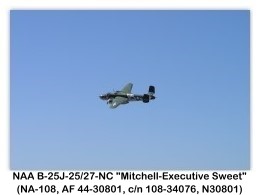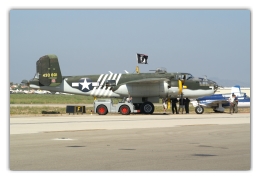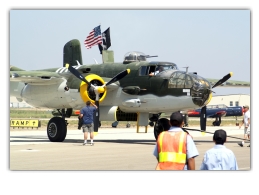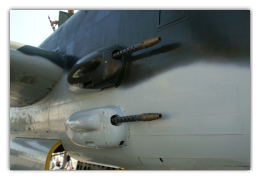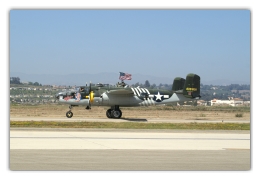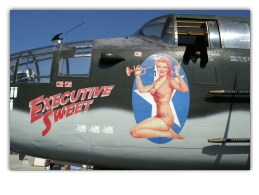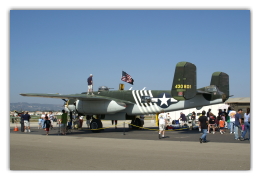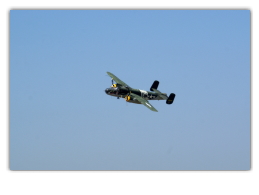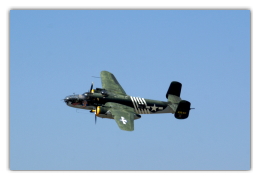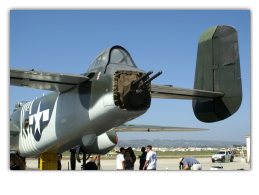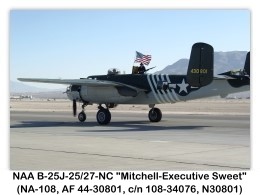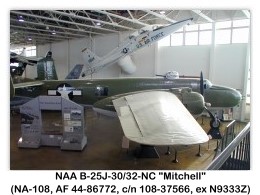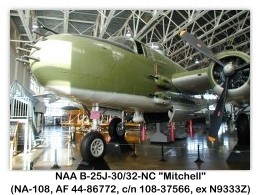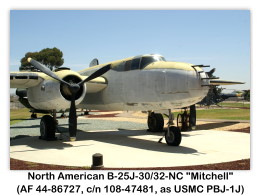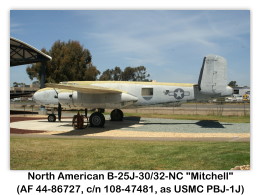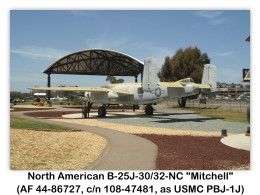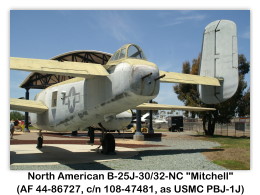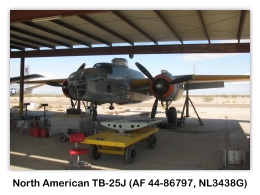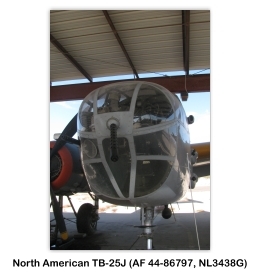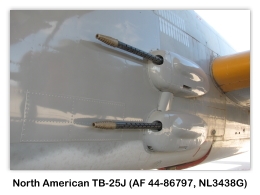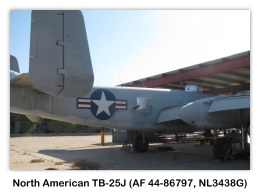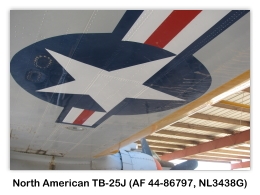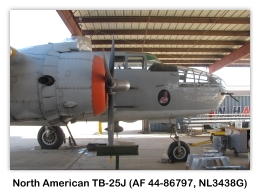












































| North American B-25D Mitchell (NA-100) | N Listings | North American P-51D Mustang (NA-109) |
North American B-25J Mitchell (NA-108)
USAAF WWII Twin-engine medium bomber
Archive Photos 1,5
North American B-25J-25/27-NC Mitchell Briefing Time (NA-108, AF 44-29939 as 43-27638, c/n 108-33214, N9456Z) circa 1998 at the Mid-Atlantic Air Museum, Reading, Pennsylvania (photo copyright © 1998 Skytamer Images by John Shupek)
North American B-25J-25/27-NC Mitchell Photo Fanny (NA-108, AF 44-30423, c/n 108-33698, N3675G) circa 8/1/1995 at the Hawthorne Air Faire, Hawthorne, California (photo copyright © 1995 Skytamer Images by John Shupek)
North American B-25J-25/27-NC Mitchell Photo Fanny (NA-108, AF 44-30423, c/n 108-33698, N3675G) circa 8/21/2003 at the Planes of Fame Air Museum, Chino, California (photo copyright © 2003 Skytamer Images by John Shupek)
North American B-25J-25/27-NC Mitchell Photo Fanny (NA-108, AF 44-30423, c/n 108-33698, N3675G) circa 8/4/2004 at the Planes of Fame Air Museum, Chino, California (photo copyright © 2004 Skytamer Images by John Shupek)
"North American B-25J-10-NC Mitchell Pacific Princess (NA-108, AF 43-28204, c/n 108-35117, N9856C, painted as PBJ-1J) on 1/7/2006 at the Cable Air Show, Cable Airport, Upland, California (photos copyright © 2006 Skytamer Images by John Shupek)"
North American B-25J-10-NC Mitchell Pacific Princess (NA-108, AF 43-28204, c/n 108-35117, N9856C, painted as PBJ-1J) on 1/11/2009 at the Cable Air Show, Cable Airport, Upland, California (photos copyright © 2009 Skytamer Images by John Shupek)
North American B-25J-20-NC Mitchell In the Mood (NA-108, AF 44-29199, c/n 108-32474, N9117E) circa 8/30/1992 at the Hawthorne Air Faire, Hawthorne, California (photo copyright © 1992 Skytamer Images by John Shupek)
North American B-25J-20-NC Mitchell In the Mood (NA-108, AF 44-29199, c/n 108-32474, N9117E) circa 5/19/2002 at the Chino Air Show, Chino Airport, Chino, California (photo copyright © 2002 Skytamer Images by John Shupek)
North American B-25J-25/27-NC Mitchell Heavenly Body (NA-108, AF 44-30748, c/n 108-34023, N8195H) 6/25/2000 at the Aviation Expo 2000, Van Nuys Airport, Van Nuys, California (photos copyright © 2000 Skytamer Images by John Shupek)
North American B-25J-25/27-NC Mitchell Heavenly Body (NA-108, AF 44-30748, c/n 108-34023, N8195H) 8/1/1995 at the Hawthorne Air Faire, Hawthorne, California (photo copyright © 1995 Skytamer Images by John Shupek)
North American B-25J-25/27-NC Mitchell Heavenly Body (NA-108, AF 44-30748, c/n 108-34023, N8195H) 11/10/2007 at the Aviation Nation 2007 Air Show, Nellis AFB, Las Vegas, Nevada (photo copyright © 2007 Skytamer Images by John Shupek)
North American B-25J-25/27-NC Mitchell Silver Lady (NA-108, AF 44-30456, c/n 108-33731, NX43BA) 4/14/2004 at the Tillamook Naval Air Museum, Tillamook, Oregon (Photos by John Shupek)
North American B-25J-25/27-NC Mitchell Executive Sweet (NA-108, AF 44-30801, c/n 108-34076, N30801) 8/1/1995 at the Hawthorne Air Faire 1995, Hawthorne, California (photo copyright © 1995 Skytamer Images by John Shupek)
North American B-25J-25/27-NC Mitchell Executive Sweet (NA-108, AF 44-30801, c/n 108-34076, N30801) 10/1/1989 at the Northrop 50 ’N Flying Family Day and Airshow, Palmdale, California (photo copyright © 1989 Skytamer Images by John Shupek)
North American B-25J-25/27-NC Mitchell Executive Sweet (NA-108, AF 44-30801, c/n 108-34076, N30801) 8/27/2005 at the Camarillo Air Show, Camarillo, California (photos copyright © 2005 Skytamer Images by John Shupek, 08/27/2005)
North American B-25J-25/27-NC Mitchell Executive Sweet (NA-108, AF 44-30801, c/n 108-34076, N30801) 8/19/2006 at the Camarillo Air Show, Camarillo, California (photo copyright © 2006 Skytamer Images by John Shupek)
North American B-25J-25/27-NC Mitchell Executive Sweet (NA-108, AF 44-30801, c/n 108-34076, N30801) 11/10/2007 at the Aviation Nation 2007 Air Show, Nellis AFB, Las Vegas, Nevada (photo copyright © 2007 Skytamer Images by John Shupek)
North American B-25J-30/32-NC Mitchell Problem Child (NA-108, AF 44-31032, c/n 108-35357, N3174G) circa 7/1990 at the March Field Museum, Riverside, California (photo copyright © 1990 Skytamer Images by John Shupek)
North American B-25J-30/32-NC Mitchell Problem Child (NA-108, AF 44-31032, c/n 108-35357, N3174G) 10/29/1998 at the March Field Air Museum, Riverside, California (photo copyright © 1998 Skytamer Images by John Shupek)
North American B-25J-30/32-NC Mitchell Problem Child (NA-108, AF 44-31032, c/n 108-35357, N3174G) 01/10/2006 at the March Field Air Museum, Riverside, California (photo copyright © 2006 Skytamer Images by John Shupek)
North American B-25J-30/32-NC Mitchell Mitch the Witch (NA-108, AF 44-86747, c/n 108-47501, N8163H) on 6/5/1999 at the Palm Springs Air Museum, Palm Springs, California (photo copyright © 1999 Skytamer Images by John Shupek)
North American B-25J-30/32-NC Mitchell Mitch the Witch II (NA-108, AF 44-86747, c/n 108-47501, N8163H) on 1/4/2006 at the Palm Springs Air Museum, Palm Springs, California (photo copyright © 2006 Skytamer Images by John Shupek)
North American B-25J-30/32-NC Mitchell (NA-108, AF 44-86772, c/n 108-37566, ex N9333Z) 11/26/2001 at the Hill Aerospace Museum, Hill AFB, Roy, Utah (Photos by John Shupek)
North American B-25J-30/32-NC Mitchell Lazy Daisy Mae (NA-108, AF 44-86891, c/n 108-47645, ex N3337G) 4/13/2007 at the Castle Air Museum, Atwater, California (photo copyright © 2007 Skytamer Images by John Shupek)
North American B-25J-35/37-NC Mitchell Grumpy (NA-108, AF 45-8883, c/n 108-47734, C-GCWM/HD372/VO-B) 9/22/2003 at the Canadian Warplane Heritage Museum, Mount Hope, Ontario, Canada (photo copyright © 2003 Skytamer Images by John Shupek)
North American B-25J-30/32-NC Mitchell (AF 44-86727, c/n 108-47481, as USMC PBJ-1J) on display 4/26/1997 at the MCAS El Toro Air Show 1997, MCAS El Toro, California (photo copyright © 1997 Skytamer Images by John Shupek)
North American B-25J-30/32-NC Mitchell (AF 44-86727, c/n 108-47481, as USMC PBJ-1J) on display 6/22/2007 at the Flying Leatherneck Historical Foundation and Aviation Museum, MCAS Miramar, San Diego, California (photo copyright © 2007 Skytamer Images by John Shupek)
North American TB-25J Mitchell Auntie Jayne (AF 44-86797, c/n 108-47551, NL3438G, 1944) on display (11/20/2011) at the Lauridsen Aviation Museum, Buckeye, Arizona (Photos by AFIA)
Overview ²
North American B-25 Mitchell
- Role: Medium bomber
- Manufacturer: North American Aviation
- Designed by: John Leland "Lee" Atwood
- First flight: 19 August 1940
- Introduction: 1941
- Retired: 1979 (Indonesia)
- Primary users: United States Army Air Forces, Royal Canadian Air Force, Royal Air Force, Soviet Air Force
- Number built: 9,984
- Developed from: XB-21
- Variants: North American XB-28
The North American B-25 Mitchell was an American Twin-engine medium bomber manufactured by North American Aviation. It was used by many Allied air forces, in every theater of World War II, as well as many other air forces after the war ended, and saw service across four decades.
The North American B-25 was named in honor of General Billy Mitchell, a pioneer of U.S. military aviation. The North American B-25 is the only American military aircraft named after a specific person. By the end of its production, nearly 10,000 B-25’s in numerous models had been built. These included a few limited variations, such as the US Navy’s and US Marine Corps’ North American PBJ-1 patrol bomber and the Army Air Forces’ North American F-10 photo reconnaissance aircraft.
Design and development ²
The North American B-25 Mitchell was a descendant of the earlier XB-21 (North American-39) project of the mid-1930s. Experience gained in developing that aircraft was eventually used by North American in designing the North American B-25 Mitchell (called the NA-40 by the company). One North American NA-40 was built, with several modifications later being done to test a number of potential improvements. These improvements included Wright R-2600 radial engines, which would become standard on the later North American B-25 Mitchell’s.
In 1939, the modified and improved North American NA-40B was submitted to the United States Army Air Corps for evaluation. This aircraft was originally intended to be an attack bomber for export to the United Kingdom and France, both of which had a pressing requirement for such aircraft in the early stages of World War II. However, those countries changed their minds, opting instead for the also-new Douglas DB-7 (later to be used by the US as the A-20 Havoc). Despite this loss of sales, the North American NA-40B re-entered the spotlight when the Army Air Corps evaluated it for use as a medium bomber. Unfortunately, the North American NA-40B was destroyed in a crash on 11 April 1939. Nonetheless, the type was ordered into production, along with the Army’s other new medium bomber, the Martin B-26 Marauder.
Early Production ²
An improvement of the North American NA-40B, dubbed the North American NA-62, was the basis for the first actual North American B-25. Due to the pressing need for medium bombers by the Army, no experimental or service-test versions were built. Any necessary modifications were made during production runs, or to existing aircraft at field modification centers around the world.
A significant change in the early days of North American B-25 production was a re-design of the wing. In the first nine aircraft, a constant-dihedral wing was used, in which the wing had a consistent, straight, slight upward angle from the fuselage to the wing tip. This design caused stability problems, and as a result, the dihedral angle was nullified on the outboard wing sections, giving the North American B-25 its slightly gull wing configuration. Less noticeable changes during this period included an increase in the size of the tail fins and a decrease in their inward cant. A total of 6,608 North American B-25 Mitchell’s were built at North American’s Fairfax Airport plant in Kansas City, Kansas.
Operational History ²
The B-25 first gained fame as the bomber used in the 18 April 1942 Doolittle Raid, in which sixteen North American B-25B Mitchell’s led by the legendary Lieutenant Colonel Jimmy Doolittle, attacked mainland Japan four months after the bombing of Pearl Harbor. The mission gave a much-needed lift in spirits to the Americans, and alarmed the Japanese who believed their home islands were inviolable by enemy troops. While the amount of actual damage done was relatively minor, it forced the Japanese to divert troops for the home defense for the remainder of the war. The raiders took off from the carrier USS Hornet and successfully bombed Tokyo and four other Japanese cities without loss. However, 15 subsequently crash-landed en route to recovery fields in Eastern China. These losses were the result of the task force being spotted by Japanese fishing vessels forcing the bombers to take off 170 mi (270 km) early, fuel exhaustion, stormy nighttime conditions with zero visibility, and lack of electronic homing aids at the recovery bases. Only one landed intact; it came down in the Soviet Union, where its five-man crew was interned and the aircraft confiscated. Of the 80 aircrew, 69 survived their historic mission and eventually made it Back to American lines.
Following a number of additional modifications, including the addition of Plexiglas windows for the navigator and radio operator, heavier nose armament, and deicing and anti-icing equipment, the North American B-25C Mitchell was released to the Army. This was the second mass-produced version of the Mitchell, the first being the lightly-armed North American B-25B Mitchell used by the Doolittle Raiders. The North American B-25C Mitchell and North American B-25D Mitchell differed only in location of manufacture: The B-25C’s were built at Inglewood, California, the B-25D’s at Kansas City, Kansas. A total of 3,915 North American B-25Cs and North American B-25Ds were built by North American during World War II.
Although the North American B-25 Mitchell was originally designed to bomb from medium altitudes in level flight, it was used frequently in the Southwest Pacific theater (SWPA) on treetop-level strafing and parafrag (parachute-retarded fragmentation bombs) missions against Japanese airfields in New Guinea and the Philippines. These heavily-armed Mitchell’s, field-modified by Major Paul I. "Pappy" Gunn, were also used on strafing and skip-bombing missions against Japanese shipping trying to re-supply their land-based armies. Under the leadership of Lieutenant General George C. Kenney, North American B-25’s of the Fifth and Thirteenth Air Forces devastated Japanese targets in the SWPA from 1942 to 1945, and played a significant role in pushing the Japanese Back to their home islands. North American B-25’s were also used with devastating effect in the Central Pacific, Alaska, North Africa, Mediterranean and China-Burma-India (CBI) theaters.
Because of the urgent need for hard-hitting strafer aircraft, a version dubbed the North American B-25G was developed, in which the standard-length transparent nose and the bombardier were replaced by a shorter solid nose containing two fixed 0.50 in (12.7 mm) machine guns and a 75 mm (2.95 in) M4 cannon, one of the largest weapons fitted to an aircraft, similar to the experimental British Mosquito Mk. XVIII, and German Ju.88P heavy cannon carrying aircraft. The cannon was manually loaded and serviced by the navigator, who was able to perform these operations without leaving his crew station just behind the pilot. This was possible due to the shorter nose of the G-model and the length of the M4, which allowed the breech to extend into the navigator’s compartment.
The North American B-25G’s successor, the North American B-25H Mitchell, had even more firepower. The M4 gun was replaced by the lighter T13E1, designed specifically for the aircraft. The 75 mm (2.95 in) gun fired at a muzzle velocity of 2,362 ft/s (about 720 m/s). Due to its low rate of fire (approximately four rounds could be fired in a single strafing run) and relative ineffectiveness against ground targets, as well as substantial recoil, the 75 mm (2.95 in) gun was sometimes removed from both G and H models and replaced with two additional .50 in (12.7 mm) machine guns as a field modification. The North American B-25H also mounted four fixed forward-firing 0.50 (12.7 mm) machine guns in the nose, four more fixed ones in forward-firing cheek blisters, two more in the top turret, one each in a pair of new waist positions, and a final pair in a new tail gunner’s position. Company promotional material bragged the North American B-25H could "bring to bear 10 machine guns coming and four going, in addition to the 75 mm cannon, a brace of eight rockets and 3,000 lb (1,360 kg) of bombs."
The North American B-25H Mitchell also featured a redesigned cockpit area, with the top turret moved forward to the navigator’s compartment (thus requiring the addition of the waist and tail gun positions), and a heavily modified cockpit designed to be operated by a single pilot, the co-pilot’s station and controls deleted, and the seat cut down and used by the navigator/cannoneer, the radio operator being moved to the aft compartment, operating the waist guns. A total of 1,400 North American B-25G Mitchell’s and North American B-25H Mitchell’s were built in all.
The final version of the Mitchell, the North American B-25J Mitchell, looked much like the earlier B-25B, B-25C and B-25D, having reverted to the longer nose. The less-than-successful 75 mm (2.95 in) cannon was deleted on the B-25J model. Instead, 800 of this version were built with a solid nose containing eight 0.50 (12.7 mm) machine guns, while other B-25J Mitchells featured the earlier "greenhouse" style nose containing the bombardier’s position. Regardless of the nose style used, all B-25J Mitchell’s also included two 0.50 in (12.7 mm) guns in a "fuselage package" located directly under the pilot’s station, and two more such guns in an identical package just under the co-pilot’s compartment. The solid-nose North American B-25J Mitchell variant carried an impressive total of 18 0.50 in (12.7 mm) guns: eight in the nose, four in under-cockpit packages, two in an upper turret, two in the waist, and a pair in the tail. No other bomber of World War II carried as many guns. However, the first 555 North American B-25J Mitchell’s (the North American B-25J-1-NC Mitchell production block) were delivered without the fuselage package guns, because it was discovered muzzle blast from these guns was causing severe stress in the fuselage; while later production runs returned these guns, they were often removed as a field modification for the same reason. In all, 4,318 North American B-25J Mitchell’s were built.
The North American B-25 Mitchell was a safe and forgiving aircraft to fly. With an engine out, 60° banking turns into the dead engine were possible, and control could be easily maintained down to 145 mph (230 km/h). However, the pilot had to remember and maintain engine-out directional control at low speeds after take off with rudder - if this was attempted with ailerons, the aircraft would snap out of control. The tricycle landing gear made for excellent visibility while taxiing. The only significant complaint about the North American B-25 Mitchell was the extremely high noise level produced by its engines; as a result, many pilots eventually suffered from various degrees of hearing loss.
The North American B-25 Mitchell was also an amazingly sturdy aircraft and could withstand tremendous punishment. One well-known North American B-25C Mitchell of the 321st Bomb Group was nicknamed "Patches" because its crew chief painted all the aircraft’s flak hole patches with high-visibility zinc chromate paint. By the end of the war, this aircraft had completed over 300 missions, was belly-landed six times and sported over 400 patched holes. The airframe was so bent, straight-and-level flight required 8° of left aileron trim and 6° of right rudder, causing the aircraft to "crab" sideways across the sky.
An interesting characteristic of the North American B-25 Mitchell was its ability to extend range by using one-quarter wing flap settings. Since the aircraft normally cruised in a slightly nose-high attitude, about 40 gal (150 L) of fuel was below the fuel pickup point and thus unavailable for use. The flaps-down setting gave the aircraft a more level flight attitude, which resulted in this fuel becoming available, thus slightly extending the aircraft’s range.
By the time a separate United States Air Force was established in 1947, most North American B-25 Mitchell’s had been consigned to long-term storage. However, a select number continued in service through the late 1940s and 1950s in a variety of training, reconnaissance and support roles. Its principal use during this period was for undergraduate training of multi-engine aircraft pilots slated for reciprocating engine or turboprop cargo, aerial refueling or reconnaissance aircraft. Still others were assigned to units of the Air National Guard in training roles in support of Northrop F-89 Scorpion and Lockheed F-94 Starfire operations. The final example of a North American B-25 Mitchell was struck from the active USAF roles in January 1959. Today, many North American B-25 Mitchell’s are kept in airworthy condition by air museums and collectors.
Empire State Building Incident ²
On Saturday, 28 July 1945, at 0940 (while flying in thick fog), a USAAF North American B-25D Mitchell crashed into the north side of the Empire State Building, hitting between the 79th and 80th floor. Fourteen people were killed ’ 11 in the building, along with Colonel William Smith and the other two occupants of the bomber. It was partly because of this incident that towers 1 and 2 of the World Trade Center were designed to withstand the impact of a Boeing 707 aircraft.
Variants ²
Bomber Variants
- B-25: The first version of the B-25 delivered. No prototypes were ordered. The first nine aircraft were built with constant dihedral angle. Due to low stability, the wing was redesigned so that the dihedral was eliminated on the outboard section. (Number made: 24.)
- B-25A: Version of the B-25 modified to make it combat ready; additions included self-sealing fuel tanks, crew armor, and an improved tail gunner station. No changes were made in the armament. Re-designated obsolete (RB-25A designation) in 1942. (Number made: 40.)
- B-25B: Rear turret deleted; manned dorsal and remotely-operated ventral turrets added, each with a pair of 0.50 in (12.7 mm) machine guns. The ventral turret was retractable, but the increased drag still reduced the cruise speed by 30 mph (48 km/h). 23 were delivered to the RAF as the Mitchell Mk I. The Doolittle Raiders flew B-25B’s on their famous mission. (Number made: 120.)
- B-25C: Improved version of the B-25B: power plants upgraded from Wright R-2600-9 radials to R-2600-13s; de-icing and anti-icing equipment added; the navigator received a sighting blister; nose armament was increased to two .50 in (12.7 mm) machine guns, one fixed and one flexible. The B-25C model was the first mass-produced B-25 version; it was also used in the United Kingdom (as the Mitchell II), in Canada, the People’s Republic of China, the Netherlands, and the Soviet Union. First mass-produced B-25 model. (Number made: 1,625.)
- ZB-25C:
- B-25D: Identical to the B-25C, the only difference was that the B-25D was made in Kansas City, Kansas, whereas the B-25C was made in Inglewood, California. First flew on 3 January 1942. (Number made: 2,290.)
- ZB-25D:
- XB-25E: Single B-25C modified to test de-icing and anti-icing equipment that circulated exhaust from the engines in chambers in the leading and trailing edges and empennage. The aircraft was tested for almost two years, beginning in 1942; while the system proved extremely effective, no production models were built that used it prior to the end of World War II. Many prop aircraft today use the XB-25E system. (Number made: 1, converted.)
- ZXB-25E:
- XB-25F-A: Modified B-25C that tested the use of insulated electrical de-icing coils mounted inside the wing and empennage leading edges as a de-icing system. The hot air de-icing system tested on the XB-25E was more practical. (Number made: 1, converted.)
- XB-25G: Modified B-25C in which the transparent nose was replaced by a solid one carrying two fixed 0.50 in (12.7 mm) machine guns and a 75 mm (2.95 in) M4 cannon, then the largest weapon ever carried on an American bomber. (Number made: 1, converted.)
- B-25G: To satisfy the dire need for ground-attack and strafing aircraft, the B-25G was made following the success of the prototype XB-25G. The production model featured increased armor and a greater fuel supply than the XB-25G. One B-25G was passed to the British, who gave it the name Mitchell II that had been used for the B-25C. (Number made: 420.)
- B-25H: An improved version of the B-25G. It featured two additional fixed .50 in (12.7 mm) machine guns in the nose and four in fuselage-mounted pods; the heavy M4 cannon was replaced by a lighter 75 mm (2.95 in) T13E1. (Number made: 1,000; number left flying in the world: 1.)
- B-25J: The last production model of the B-25, often called a cross between the B-25C and the B-25H. It had a transparent nose, but many of the delivered aircraft were modified to have a solid nose. Most of its 14-18 machine guns were forward-facing for strafing missions. 316 were delivered to the Royal Air Force as the Mitchell III. (Number made: 4,318.)
- CB-25J: Utility transport version.
- VB-25J: A number of B-25’s were converted for use as staff and VIP transports. Henry H. Arnold and Dwight D. Eisenhower both used converted B-25J’s as their personal transports.
Trainer Variants
Most models of the North American B-25 Mitchell’s were used at some point as training aircraft.
- TB-25D: Originally designated AT-24A (Advanced Trainer, Model 24, Version A). Trainer modification of B-25D. In total, 60 AT-24s were built.
- TB-25G: Originally designated AT-24B. Trainer modification of B-25G.
- TB-25C: Originally designated AT-24C. Trainer modification of B-25C.
- TB-25J: Originally designated AT-24D. Trainer modification of B-25J. Another 600 B-25J’s were modified after the war.
- TB-25K: Hughes E1 fire-control radar trainer (Hughes). (Number made: 117.)
- TB-25L: Hayes pilot-trainer conversion. (Number made: 90.)
- TB-25M: Hughes E5 fire-control radar trainer. (Number made: 40.)
- TB-25N: Hayes navigator-trainer conversion. (Number made: 47.)
USN/USMC Variants
- PBJ-1C: Similar to the B-25C for the US Navy; often fitted with airborne search radar and used in the anti-submarine role.
- PBJ-1D: Similar to the B-25D for the US Navy and US Marine Corps. Differed in having a single 0.50 in (12.7 mm) machine gun in the tail turret and beam gun positions similar to the B-25H. Often fitted with airborne search radar and used in the anti-submarine role.
- PBJ-1G: US Navy/US Marine Corps designation for the B-25G
- PBJ-1H: US Navy/US Marine Corps designation for the B-25H
- PBJ-1J: US Navy designation for the B-25J-NC (Blocks -1 through -35) with improvements in radio and other equipment. Often fitted with "package guns" and wingtip search radar for the anti-shipping/anti-submarine role.
Operators ²
- Australia: Royal Australian Air Force, No. 2 Squadron RAAF
- Argentina
- Biafra: Biafran Air Force operated two aircraft.
- Bolivia
- Brazil: Brazilian Air Force (75 units)
- Canada: Royal Canadian Air Force
- China
- People’s Republic of China: People’s Liberation Army Air Force operated captured Nationalist Chinese aircraft.
- Chile
- Colombia
- Cuba
- Dominican Republic
- France
- Indonesia: Indonesian Air Force received some B-25 Mitchell’s from Netherlands, the last example retired in 1979.
- Mexico
- Netherlands: Royal Netherlands Air Force, No. 18 (Netherlands East Indies) Squadron RAAF, No. 119 (Netherlands East Indies) Squadron RAAF, No. 320 Squadron, Royal Dutch Naval Air Service
- Peru
- Poland: Polish Air Forces on exile in Great Britain, No. 305 Polish Bomber Squadron
- Spanish State: Spanish Air Force
- Soviet Union: Soviet Air Force received a total of 866 B-25’s (of types C/D/S/G/J).
- United Kingdom: Royal Air Force received more than 900 aircraft. United States: United States Army Air Forces, United States Navy, United States Marine Corps
- Uruguay
- Venezuela
Specifications and Performance Data (B-25D) 3,4
B-25C/D; PBJ-IC; Mitchell II
Type:
- These models were virtually the same as the B-25B but were equipped with automatic flight control equipment.
- Wright R-2600-13 engines with 1,700-hp available for take-off were substituted for the earlier power-units.
- The B-25C were built in the Inglewood, California plant, the B-25D was built in the Kansas City plant.
- The Mitchell II was first reported in action with the RAF on January 22, 1943.
Wings:
- Five-seat Twin-engine medium bomber.
Fuselage:
- High-wing cantilever monoplane all-metal construction.
- In five parts comprising center-section detachable from fuselage, outer wing sections detachable from center-section and two removable wing-tips.
- Outer wing-sections are of the, single-spar type with smooth "Alclad" skin.
- Fuel tanks integral with center-section.
- Oil tanks in leading-edge of the center-section.
- Ailerons have metal frames and fabric covering.
- Wing-flaps are of the slotted type, are in two sections, and are hydraulically operated.
- Leading-edges of wings have ice eliminators.
Tail Unit:
- Semi-monocoque structure of aluminium-alloy with covering of same material.
- That portion of the fuselage above the bottom surface of the wing and between front spar and trailing-edge is permanently attached to the wing and is removable with the center-section.
Undercarriage:
- Cantilever monoplane type with twin fins and rudders.
- De-icer on leading-edges of horizontal and vertical surfaces.
Power Plant:
- Tricycle type with all wheels fully retractable.
- Hydraulic retraction.
- Main landing wheels retract into engine nacelles and apertures, closed by hinged panels when wheels are retracted.
- The nosewheel is fully cantilever and is mounted on a trunnion directly attached to the lower side of a fuselage structural bulkhead.
- Wheel-brakes on main wheels.
Accommodation:
- Two Wright "Cyclone" R-2600-13 two-row radial air-cooled 1,700-hp engines in semi-monocoque nacelles below extremities of center-section.
- Three-bladed constant-speed full-feathering airscrews with anti-icers.
- Fuel tanks (total. capacity 916 U.S. gallons) integral with center-section.
- Two oil tanks (48 U.S. gallons capacity) in leading-edge of center-section
Dimensions:
- Provision for crew of five — pilot, second pilot, bomber, radio operator-gunner and armorer-gunner.
- All members of crew may interchange position in the air.
- Bombaimer’s position in nose.
- Pilot’s cockpit forward of airscrew plane.
- Internal bomb stowage in fuselage beneath center-section.
- Bombaimer has alternative position aft of the pilot.
- Radio operator-gunner and armorer-gunner are stationed aft of bombing-bay in rear fuselage.
Weights and Loadings:
- Span: 67 ft 6.75 in (20.6 m)
- Length: 54 ft 0.81 in (16.6 m)
- Height: 15 ft 9.81 in (4.6 m)
- Wing area: 610 ft² (57.7 m²)
Armament: 4
- Weight empty: 16,000 lbs. (7,256 kg)
- Disposable load: 8,000 lbs (3,627 kg)
- Weight loaded: 24,000 lbs (10,886 kg)
- Wing loading: 39.35 lbs/ft² (192.1 kg/m²)
- Power loading: 7.5 lbs/hp (3.4 kg/hp)
Performance: 4
- One 0.30-in gun in nose
- Two 0.50-in guns each in dorsal and ventral turrets
- Bomb load: 3000 lbs
- Cruising speed: 233 mph
- Maximum speed: 284 mph
- Landing speed: 105 mph
- Climb rate: 950 ft/min
- Service ceiling: 21,200 ft
- Range: 1,500 miles with 3,000-lb bomb load
References
- Photos: John Shupek, Copyright © 1989-2012 Skytamer Images. ALL RIGHTS RESERVED
- Wikepedia B-25 Mitchell
- Bridgman, Leonard (editor.), Jane’s All The World’s Aircraft 1941, New York: The MacMillan Company, 1942, pp 198c - 199c
- Avery, Norm, North American Aircraft 1934-1998, Volume 1, Santa Ana: Narkiewicz//Thompson, 1998, ISBN 0-913322-05-0
- Photos: A Friend In Arizona (AFIA), 11/20/2011
| Home
| Archive Subscriber Support
| Guestbook
| Contact Us
| Legal Notice
| Aviation Links
|
Copyright © 2012 Skytamer Images, Whittier, California
ALL RIGHTS RESERVED




